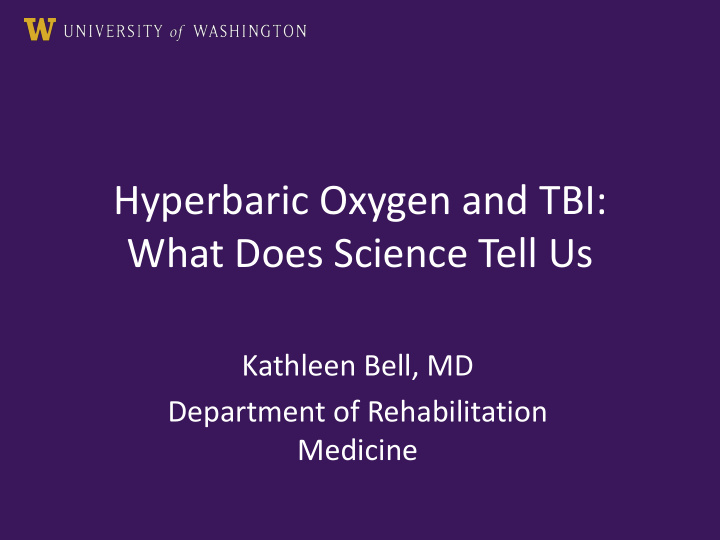



Hyperbaric Oxygen and TBI: What Does Science Tell Us Kathleen Bell, MD Department of Rehabilitation Medicine
• Look at scientific research on using hyperbaric oxygen treatment and neurofeedback treatment to improve outcomes after TBI • Discussion • No conflicts of interest to report (neither Dr. Bell or Zumsteg receives any money from anyone connected with these topics)
History of HBOT Circa 1960’s 2011
Decompression Illness – The “Bends” Brooklyn Bridge 1883
Current Indications for HBOT Air or gas embolism Gas gangrene Crush injury Compartment syndrome Acute peripheral ischemias Decompression sickness Enhanced healing in selected problem wounds Exceptional blood loss anemia Necrotizing soft tissue infections Osteomyelitis Delayed radiation injury (soft tissue and bony necrosis) Compromised skin grafts and flaps Carbon monoxide poisoning
Ideal Gas Laws Henry’s law The amount of gas dissolved in a liquid is equal to the partial pressure of the gas exerted on the surface of the liquid. By increasing the atmospheric pressure in the chamber, more oxygen can be dissolved into the plasma than would be seen at surface pressure
What does this mean for oxygen and the body? • At sea level, the atmospheric pressure surrounding the body is “1 atmosphere (or ATM)” (or 14.7 psi) • At 33 feet below sea level, “1.5 atmospheres (or ATM)” • Most treatments for HBOT • Pressure used for animal studies 1.5-3 ATM and duration of treatment is 1-3 hours
Neural Tissue and HBOT • In animal and human experiments, HBO has resulted in – Temporary increase in oxygen pressure in the brain – Changes in blood flow – Reduced intracranial pressure **All of these experiments were done after ACUTE brain injury
Animals with Stroke • In animals with a variety of stroke types, acute HBOT resulted in: – ↓ size of brain stroke, – ↓ brain swelling, – Stabilization of barrier between the brain and blood circulation – ↓ cell death, – improved glucose uptake, – improved neurobehavioral scores
• However, the results decreased the longer that ischemia (or decreased blood flow) lasted – In fact, some studies demonstrated worse outcome
Human Studies/Stroke • Rusyniak (2.5 ATA x 1 hr) – No benefit at 24 hours, worse at 90 days • Vila, 2005 Chronic cerebrovascular disease – improved motor and cognitive function • Pretreatment CABG – improved neuropsychological scores postoperatively Rusyniak et al. Stroke 2003;34:571-574. Vila et al. Undersea Hyperb Med 2005;32:341-349.
What are the theories for how HBOT works to reduce tissue damage? • Increased oxygen content to the tissues which would have otherwise had lower oxygen In strokes – may also improve local metabolism Transient •
• Reduce excitotoxicity – Decrease some of the toxic metabolites like lactate and glutamate – Reduce dopamine levels – Help to preserve dopamine levels • Stabilizes the barrier between the brain and blood
• Reduces stress caused by oxidation (overly high levels of brain activation) – Decreases breakdown of membranes which release enzymes • Lipid peroxidase, NADPH oxidase, superoxide dismutase – Elevates magnesium levels
• Decreases indicators of inflammation – Less white blood cell infiltration – Less enzymatic activity – Less release of cellular inflammatory compounds • (e.g., prostaglandins, prostacyclins)
HBOT and TBI • Very few controlled studies • Mostly case studies or case series
HBOT and TBI • Artru (1976) – 60 patients in coma randomized to standard care or treated with 2.5 atm 60 min daily for 10 days/off/10 days…until death or recovery of consciousness • 12 months: similar mortality, improved but not significant recovery of consciousness • Treatment DCd in 35% due to pulmonary complications
HBOT and TBI • Rockswold (1992) – 168 patients with severe acute TBI, 6-24 hours after admission random assignment • HBOT 1.5 atm 60 minutes q 8 hrs for 2 weeks OR brain death OR following simple commands (average 21 treatments) • 12 months: HBOT lower mortality but no difference in dead/severely disabled outcomes • Tx DCd in 12% due to adverse effects (also began doing myringotomies part way through study)
HBOT and TBI • Rockswold (2009) – 69 pts randomized for HBOT (60 min, 1.5 ATA) vs. normobaric hyperoxia (3 hrs, 100% O2, 1 ATA) vs. standard care – once daily for 3 days • Measured the amount of O2 in brain tissue • Brain tissue O2 significantly increased for both experimental conditions in a graded fashion – HBO more robust effect and lowered ICP more effectively
HBOT and Chronic TBI • Harch (2007) – 64 rats with unilateral cortical contusion tested with Morris Water Task 30 days post injury • 3 groups: untreated controls, HBOT (1.5ATA, 90 min, bid, 7 days/week – total 80 treatments), sham HBOT • HBOT: increased vascular density in injured hippocampus • HBOT: improved spatial learning
HBOT and Chronic TBI • Golden (2006) – Children, mixed diagnosis convenience sample vs. retrospective data from children with brain disorders (who had been through other types of treatments) and controls • Test-retest at 4-8 weeks (no comment on validity of retesting in short intervals) – Improvement on all scores for group, high variability
Current Studies • HBOT for PCS after mTBI – Virginia Commonwealth (post-deployed military) NCT01220713 • HBOT for mild/moderate TBI – San Antonio (post- deployed military) NCT00810615 • Multicenter HBOT trial – USAMRMC NCT01306968 • HBOT in Chronic TBI or PTSD – ongoing, not recruiting (Consortium HBOT Centers) NCT01105962
Take home Messages • HBOT is do-able for acute TBI – But few hospitals are equipped – AND the research evidence does not yet support doing this on a routine basis • May be fewer deaths • No evidence that people do better in long run • Good preliminary evidence in animals and a little good evidence in people • HBOT is pretty safe for acute TBI – Ear pressure problem, rare seizure – Claustrophobia
Take home Messages • Not much evidence on how effective HBOT really is for chronic TBI – Ongoing studies may help in illuminating this
Thank you!
Recommend
More recommend